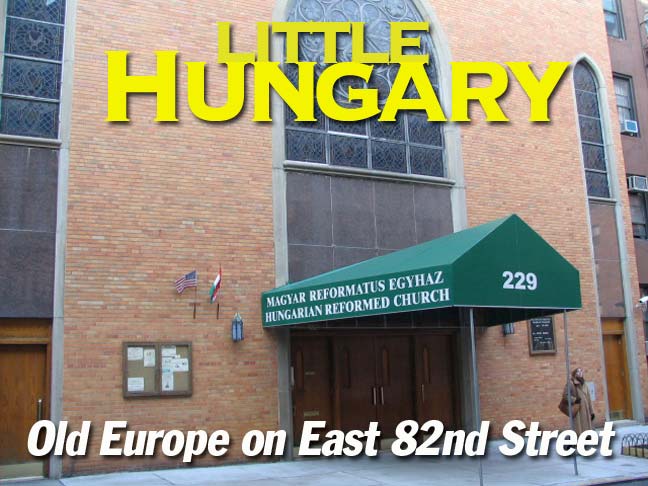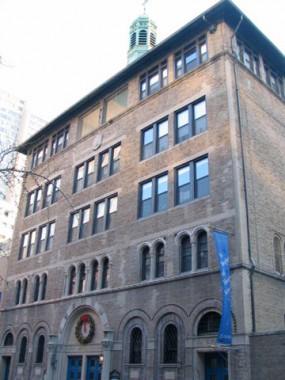During explorations of Lascoff’s Drugstore, the remains of the German-American neighborhood Yorkville, and the old signage of the Lexington Candy Shop a couple of winters ago, ForgottenFan Vicki and I also discovered the remnants of a Hungarian-American enclave on East 82nd Street in the vicinity of 3rd and Lexington Avenues.
I shouldn’t have been surprised — the Upper East Side has been an enclave for many European peoples. As a letter to the New York Times in 1983 revealed:
The Hungarian Boulevard was 79th Street, a hub for the Austro-Hungarian populace from 75th Street to 83rd Street. Popular restaurants included the Viennese Lantern, Tokay, Hungarian Gardens, Budapest and the Debrechen. There were also a number of butcher stores and businesses that imported goods from Hungary, a few of which still exist. Churches included St. Stephen (82nd St.) Catholic Church and the Hungarian Reformed Church on East 82nd Street, all of which still exist.
The federal-style townhouse at 213 East 82nd with the metal porch boasts a plaque indicating in Hungarian and English that Joseph Cardinal Mindszenty visited here May 7, 1974. In his day, Mindszenty (1892-1975) was an implacable opponent of both Nazi and Communist domination of eastern Europe; he was tortured and held prisoner by the Communist Party in Hungary between 1949 and 1956.
Since 1966, the building has been home to the American-Hungarian Library and Historical Society.
Hungarian Reformed Church, 229 East 82nd. The church was constructed in 1959; services are conducted in both Hungarian and English.
Holy Cross Byzantine Catholic Church, 313 East 82nd Street. Can’t find much information regarding the church, but the sign is partially in Hungarian.
ForgottenFan Robert Kerby: Regarding your very recent “Little Hungary” Slice, I checked with a fellow Eastern Catholic priest (who is lucky enough to reside in The City) regarding Holy Cross Byzantine Catholic Church, about which you — uncharacteristically — “can’t find much information….” No wonder! My correspondent says “Holy Cross is attached to life by the slenderest of threads.”
The parish is subordinate to the Byzantine Catholic Eparchy (Diocese) of Passaic NJ, whose jurisdiction encompasses much of the northeastern US. In common parlance, this is a “Ruthenian-Rite” Catholic diocese, overseeing Byzantine communities drawn from the old Austro-Hungarian Empire — mostly Slavic in character, but also including some other ethnicities. The Eparchy’s parishes in New York State are listed here.
Holy Cross is one of very few surviving Magyar-speaking parishes in the US. (The “neighboring” Hungarian parish at Bridgeport CT closed about five years ago.) The Hungarian priest named on the bulletin board shown in your FNY display, Fr. Andor Rakaczki, died, prematurely, two or three years ago. Most of the parish’s families had already moved away, mostly to Joisey, thanks to the neighborhood’s gentrification. Currently, a single weekly Divine Liturgy (Mass) is served — for a very few people — late Saturday afternoons, by the priest from St. Mary’s Byzantine Catholic (Ruthenian) Church on 15th Street– apparently, in a language other than Magyar. (An aside: I remember St. Mary’s celebrating in English before Vatican II discovered there were languages other than Latin!)
The building itself is a former synagogue. The neighboring rectory (parish house) was sold by the Eparchy years ago. Evidently (in my correspondent’s opinion), Holy Cross survives on the proceeds of that sale, and the abiding ardor of Hungarian nationalism.
St. Stephen of Hungary Church, 414 East 82nd Street, established in 1902; the current Art Deco church was constructed in 1927. Stephen (975-1038) was crowned the first king of Hungary by Pope Silvester II on December 25, 1000. He moved quickly to spread Christianity in a then-united Hungary, establishing a tithe system to assist churches and the poor; he also attempted to rid pagan influence from the country by force. He was canonized in 1083 and is regarded as the patron saint of Hungary. His right hand is kept as a relic in Budapest basilica.
Photographed February 2008; page completed June 25, 2009.











9 comments
Loved reading about the Hungarian past. Thank you
I AM WANTING CONTACT WITH THE HUNGARIAN REFORM CHURCH OR LIBRARY OR COMMUNITY HUNGARIAN SCHOOL……I TOO AM PURE FINNO-UGRIAN HUNGARIAN AND LIVE IN NY……CONTACT ME BY MAIL AFTER CALLING ME BY PHONE…607-733-7710…I WILL WAIT TO HEAR FROM YOU…PLEASE CALL EVENINGS OR AROUND EARLY MORNING…..I AM A BIBLE HISTORIAN………DIANE KORNELIA KALMAR, OHLS…….MY EMAIL ADDRESS IS BLOCKED BECAUSE OF HACKERS…SO PHONE ME……TODAY.
I miss the Old Hungarian neighborhood, restaurants, old bakery, hairsalon, Hungarian travel agency and everything we had in Yorkville, in the seventies and eighties…..
Most of the old Hungarian presence was gone even before the German presence in Yorkville faded, but, churches aside, the last few holdouts of the past included Paprika Weiss, an Hungarian delicatessen, which closed in the early 90s, and Yorkville Meat Packing, a terrific butcher shop and imports store on 81 st., which closed about 5 years ago. The only Hungarian shop still around that I know of is the Budapest cafe (formerly Andre’s Cafe, and still going by that name on their website) on Second Avenue.
There was once St. Elizabeth of Hungary Roman Catholic Church on the north side of East 83rd Street, between Second and Third Avenues. They had ministry to the deaf community.
What was Hungarian restaurant in the 80s on 58 Street?
Our beloved Yorkville we miss you. When I moved in in 1964 we had such a great neighborhood great food great dance places wonderful desserts cafes. Wish we could turn back time
My parents were immigrants who arrived in NYC just months after the uprising in Budapest in 1956. They lived in the city for about five years but ended up in New Jersey where I was born in 1961. They always spoke lovingly of the “Hungarian Neighborhood” on 2nd Ave. I was recently reminded of the Hungarian district in NYC but I never new exactly where on 2nd Avenue the neighborhood was and was hoping to get some answers on the internet. I found them here – thank you!
My grandparents left Austria-Hungary for the US around WW1. They married and had their seven children in Northampton, Pennsylvania between 1916 and 1931. When Grandfather died suddenly in 1931, Grandmother and five children, including my just born father, moved to Yorkville. They lived at 418 East 81st Street. Dad attended St Stephan’s school. He told many stories of the fun they had, like cooking potatoes and apples over trash can fires in winter and of being punished for swimming in the, then filthy, East River in summer. It was sometimes difficult for immigrants. My aunts spoke of the cousins that would come over while the kids were at school, to sleep in the beds, shared in shifts, the cousins worked at night when the kids were home.